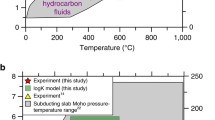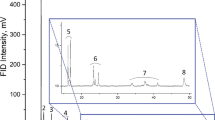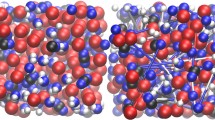Abstract
Experimental results and geological observations suggesting the existence of a deep hydrocarbon cycle are presented. During immersion hydrocarbons accumulated in the Earth’s crust in the slab generally maintain stability to a depth of 50 km. With deeper immersion, the hydrocarbon fluids contact the surrounding ferrous minerals forming a mixture of iron hydride and iron carbide on the depths of 100–290 km. Iron carbide transported into the asthenosphere by convective flows can act as carbon donors and react with hydrogen donors presented in the asthenosphere and form an aqueous-hydrocarbon fluid. This fluid can migrate through deep faults into the Earth’s crust and form oil and gas deposits.


Similar content being viewed by others
REFERENCES
D. A. Sverjensky, V. Stagno, and F. Huang, Nat. Geosci. 7, 909–913 (2014). https://doi.org/10.1038/NGEO2291
J. F. Kenney, V. G. Kutcherov, N. A. Bendeliani, et al., Proc. Natl. Acad. Sci. (USA) 99, 10976–10981 (2002).
V. G. Kucherov, A. Yu. Kolesnikov, T. I. Dyuzheva, et al., Dokl. Phys Chem. 433 (3), 132–135 (2010).
A. B. Belonoshko, T. Lukinov, A. Rosengren, et al., Sci. Rep. 5, 18382 (2015).
A. Y. Kolesnikov, J. M. Saul, and V. G. Kutchero, ChemistrySelect 2 (4), 1336–1352 (2017).
A. Yu. Serovaiskii, in Proc. Bakirov Readings (Neft’ i gaz, Moscow, 2018), pp. 147–155 [in Russian].
A. Yu. Serovaiskii, A. Yu. Kolesnikov, and V. G. Kucherov, Geochem. Int. 57 (9), 1008–1014 (2019).
E. Mukhina, A. Kolesnikov, and V. Kutcherov, Sci. Rep. 7, 5749 (2017).
K. S. Ivanov, in The Main Features of Geological History (1.6-0.2 Eon) and of Ural’s Structure (Ural Branch RAS, Yekaterinburg, 1998) [in Russian].
D. S. Shteinberg and M. V. Lagutina, in Carbon in Ultrabasites and Basites (Nauka, Moscow, 1984) [in Russian].
J. Yang, P. T. Robinson, and Y. Dilek, Episodes 38 (4), 344–364 (2015).
V. I. Lennykh, P. M. Valizer, R. Beane, et al., Int. Geol. Rev. 37 (7), 584–600 (1995).
R. Sugisaki and K. Mimura, Geochim. Cosmochim. Acta 58 (11), 2527–2542 (1994).
C. E. Melton and A. A. Giardini, Geochim. Cosmochim. Acta 60 (56), 413–417 (1975).
A. A. Tomilenko, S. V. Konovyazin, L. N. Pokhilenko, et al., Dokl. Earth Sci. 426 (4), 695–699 (2009).
Author information
Authors and Affiliations
Corresponding author
Additional information
Translated by D. Voroshchuk
Rights and permissions
About this article
Cite this article
Kutcherov, V.G., Dmitrievsky, A.N., Ivanov, K.S. et al. The Deep Hydrocarbon Cycle: From Subduction to Mantle Upwelling. Dokl. Earth Sc. 492, 338–341 (2020). https://doi.org/10.1134/S1028334X20050098
Received:
Revised:
Accepted:
Published:
Issue Date:
DOI: https://doi.org/10.1134/S1028334X20050098




